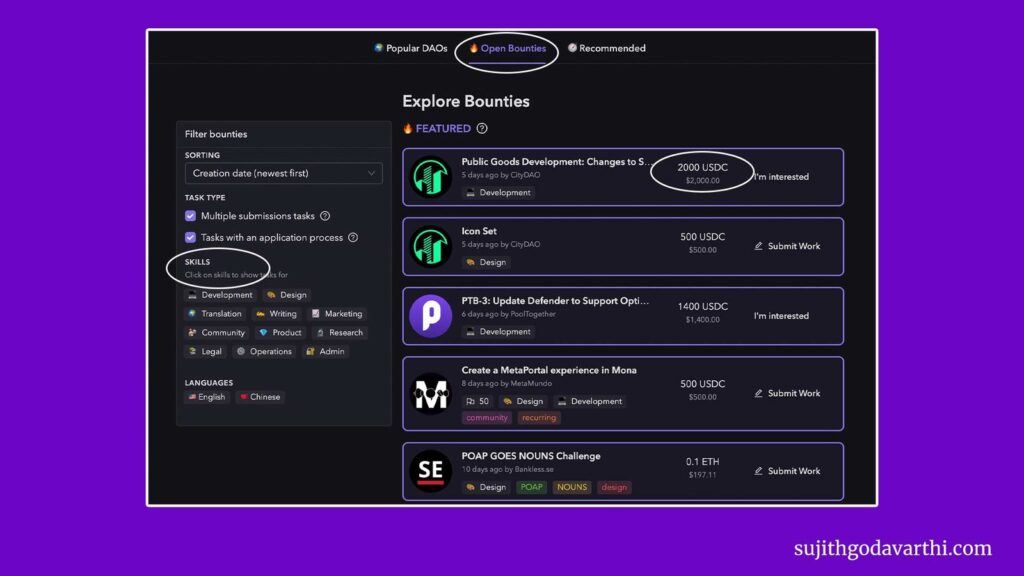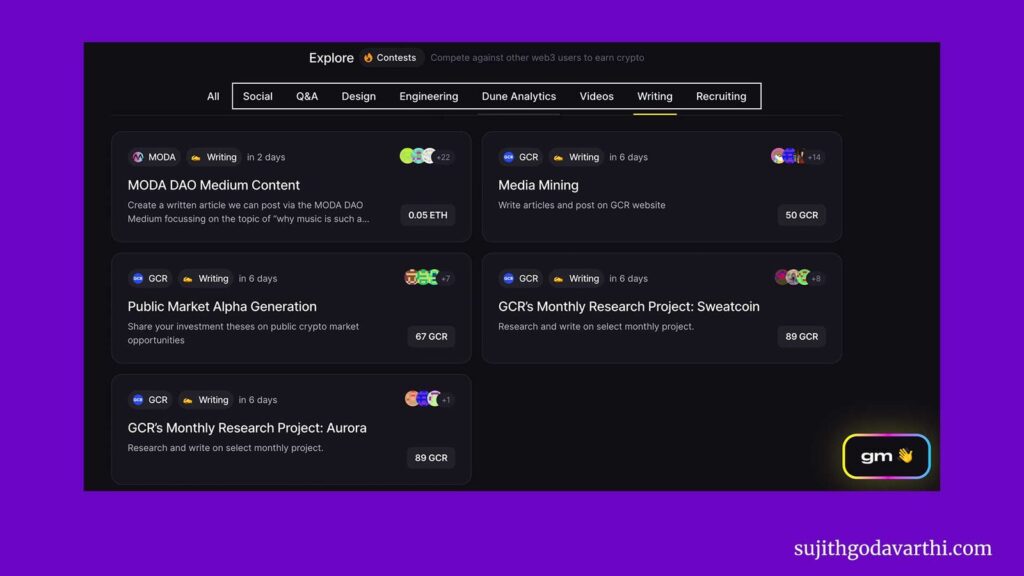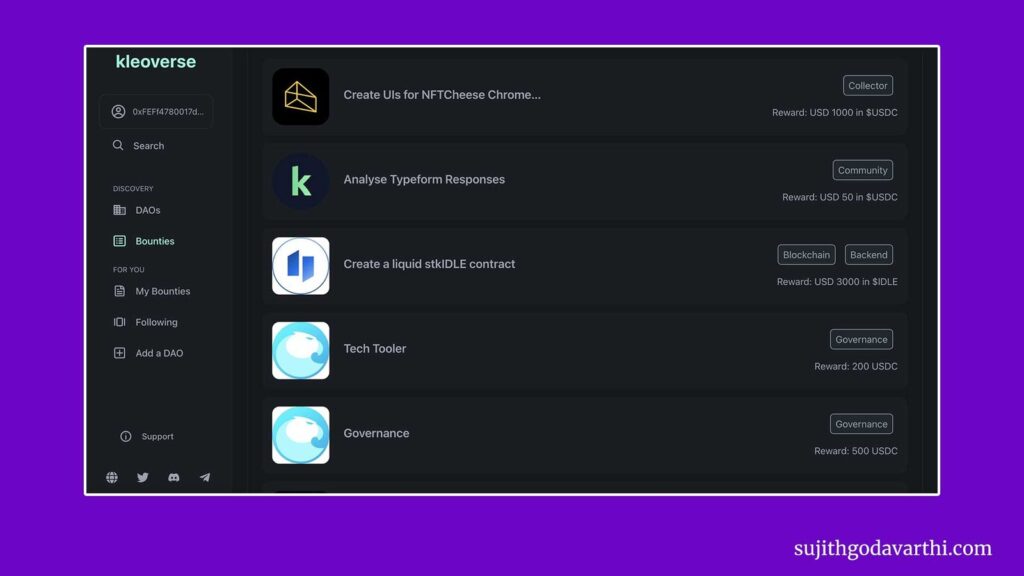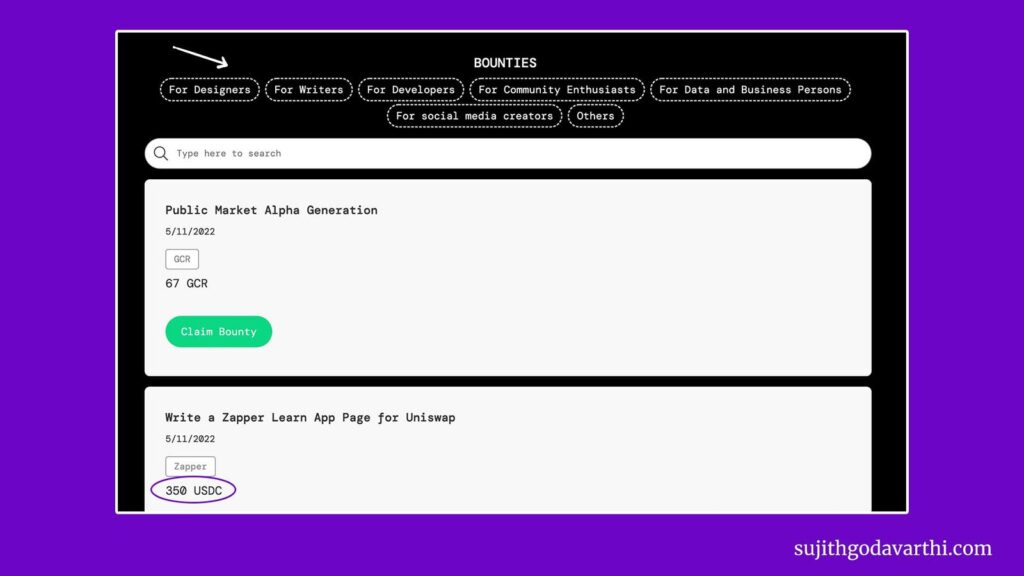Web3 is gonna change the way people do business with each other.
We have DAOs, DApps, and even Protocols (underlying infrastructure) that are being built continuously to create a better and Decentralised internet.
And since all the applications are built on the principle of “Open” and “Permissionless”, the business interactions are gonna happen (are happening) in the same way too.
Anybody, despite where you are from and what is your background can come and work together. And an individual who is looking to work on web3 projects can leverage bounties.
Web3 bounties are a permissionless way to get started in doing the work and get paid once the work is done.
Your work will speak for you when it comes to getting paid and your wallet will be your identity.
Ok, but who is putting these bounties? DAOs, Defi Protocols, NFT projects, and other web3-related projects definitely need some help when it comes to finishing their tasks.
And when the team decides to outsource their tasks, they decide to put them up as bounties and invite contributors (someone who can contribute to the project with their skills) to work on the task.
Every bounty is set up with a reward which will be paid to the contributor who finishes the job. And the reward can be in the DAOs native token or a stable coin or even BTC or ETH.

This is where the “Skin In The Game” aspect comes into play.
Let’s say you worked as a contributor for a DAO and got paid in their native tokens.
Now let’s assume that the DAO succeeded in its mission and gained some traction.
Then the value of the token will go up and you can benefit from that even though you are not working for them anymore (if you are still holding those tokens).
On the other side, the tokens may become worthless, and worse, you might even have to pay taxes on them based on the price of the tokens at the time you received them in your wallet.
Along with good skills to finish the work, one needs to have a good judgment when it comes to working for bounties that pay them in native tokens.
You can always swap them for USDC once you receive them anyway, just in case you don’t want to take the risk.
If you are thinking becoming a web3 contributor is just all about writing code and finding bugs, then you are wrong.
Yes, if you can code, you definitely have an advantage that people from other fields don’t have. And even get paid huge.
Do you know? Polygon paid $2M to Gerhard Wagner as a Bug Bounty for finding the bug that protected the $850M crypto fund.
Anyways, my point is coding can help you get paid on the scale, but that is not the only contribution needed for web3 projects.
Web3 projects also require Graphic Designers (for example every DAO needs a logo), Content Writers (Content marketing is still valid in the web3 world), Web Developers, Community Managers (NFT projects), Discord Moderators, etc.
And just to give you an idea, this is how the web3 non-tech workers get paid (This is for full-time, not based on bounties) according to Web3.career:

Ok, you know what skills you can offer and what kind of skills web3 teams are looking for. And you also understand the skin in the game aspect of getting paid for the work.
Note: If you don’t have a Metamask wallet where you will be receiving the bounty rewards, I’d recommend you to check this guide.
Now, where to find work? In other words: “How do I find bounties?”. Well, I have some suggestions for you on where you should be looking for:
Twitter is the platform one should be looking for when it comes to doing business related to crypto.
A lot of crypto projects make their announcements on Twitter, whether they are hiring, looking for contributors, or even need help with any kind of task outsourcing.
Even if you don’t find any of these announcements quite often, it’s always better to stay active anyway, because that is how you find new upcoming and interesting projects.
If you find a DAO that you think you can help via your design skills or your marketing skills, make sure you get into the discord group and introduce yourself. And let them know how you can help them in building the project.
And most DAOs have their own workboard which might be private. By workboard, I mean a google document, or an excel sheet, or even a Notion page which you won’t find unless you get into the discord group.
You start with Twitter. You’ll eventually end up in Discord DMs.
This approach might take time, but I think it is the best way to build long-term relationships with the DAO community.
Yes, all these web3 job boards list mostly full-time jobs, but approaching them (cold messaging or emailing) as a freelancer/part-time work by sharing your past experience won’t hurt.
And moreover, I’ve seen a few part time/freelancer roles in these job boards that might help you get started in web3.
Here are some web3 job boards that you try:
One advantage with these job boards is we get to know what the teams are actually looking for.
Along with job boards, there are a few web3 bounty boards that some devs have worked on. And this number should increase as we get more traction to web3.
Let’s have a look at some of these:
Dework is a task managing application like Trello, but in a web3 way. I’d recommned you to read this article to know more about this tool.
But, this is where things gets interesting. Dework has an Open Bounty section, where you can find a lot of bounties to work on and you can even filter them based on your skills.

Layer3 lists out a lot of contests which anyone can apply, do the work and submit it. Only the winner will be rewarded.
You can even sort through the contests based on the category you are looking to work on.

Kleoverse makes DAO discovery easy. They have a list of DAOs. From social and product DAOs to protocol and Defi DAOs, you can find the list here.
You can maybe get into the DAOs discord and probably find opportunities or ways to collaborate with them.
Another way to find opportunities is to directly look for bounties.

Similar to the tools we have seen before, Voice DAO also has a bounty section, and also has the categories option for easy navigation.

Bounties are one of the best options to get started in web3 and I hope the tools and methods I’ve listed out in this article made sense.